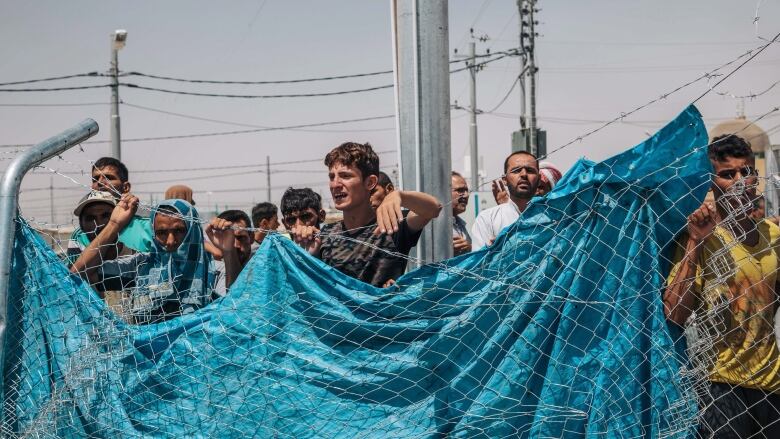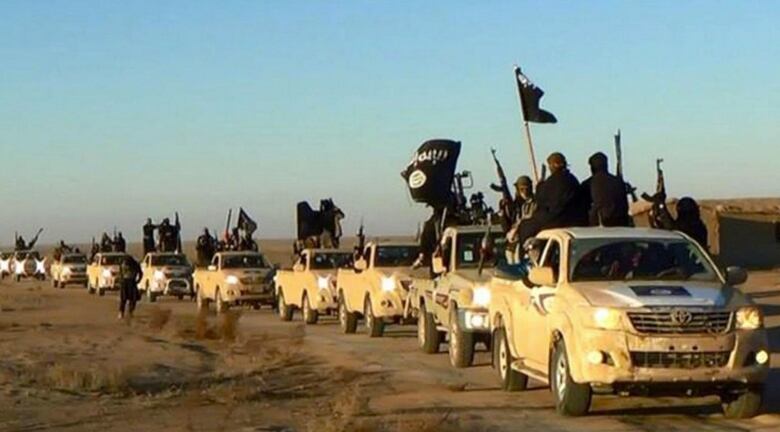ISIS buried thousands in 72 mass graves, AP investigation finds
Number of victims estimated to be between 5,200 and 15,000

Surrounded by smoke and flames, the sound of gunshots echoing around him, the young man crouched in the creek for hours, listening to the men in his family die.
On the other side of the mountain, another survivor peered through binoculars as the handcuffed men of neighbouring villages were shot and then buried by a waiting bulldozer. For six days he watched as the extremists filled one grave after another with his friends and relatives.
- More Canadians travelling abroad to join ISIS, other terrorist groups, report says
-
Baghdad bombing death toll hits 250, Iraq's interior minister resigns
Between them, the two scenes of horror on Sinjar mountain contain six burial sites and the bodies of more than 100 people, just a small fraction of the mass graves ISIS extremists have scattered across Iraq and Syria.
In exclusive interviews, photos and research, The Associated Press has documented and mapped 72 of the mass graves, the most comprehensive survey so far, with many more expected to be uncovered asgroup's territory shrinks.

In Syria, AP has obtained locations for 17 mass graves, including one with the bodies of hundreds of members of a single tribe all but exterminated when ISIS extremists took over their region. For at least 16 of the Iraqi graves, most in territory too dangerous to excavate, officials do not even guess the number of dead. In others, the estimates are based on memories of traumatized survivors, ISISpropaganda and what can be gleaned from a cursory look at the earth. Still, even the known victims buried are staggering from 5,200 to more than 15,000.
Sinjar mountain is dotted with mass graves, some in territory clawed back from ISIS after the group's onslaught against the Yazidi minority in August 2014; others in the deadly no man's land that has yet to be secured.
The bodies of Talal Murat's father, uncles and cousins lie beneath the rubble of the family farm, awaiting a time when it is safe for surviving relatives to return to the place where the men were gunned down. On Sinjar's other flank, Rasho Qassim drives daily past the graves holding the bodies of his two sons. The road is in territory long since seized back, but the five sites are untouched, roped off and awaiting the money or the political will for excavation, as the evidence they contain is scoured away by the wind and baked by the sun.

"We want to take them out of here. There are only bones left. But they said 'No, they have to stay there, a committee will come and exhume them later,"' said Qassim, standing at the edge of the flimsy fence surrounding one site, where his two sons are buried. "It has been two years but nobody has come."
ISIS boasted of atrocities
ISIS made no attempt to hide its atrocities. In fact it boasted of them. But proving what United Nations officials and others have described as an ongoing genocide and prosecuting those behind it will be complicated as the graves deteriorate.
"We see clear evidence of the intent to destroy the Yazidi people," said Naomi Kikoler, who recently visited the region for the Holocaust Museum in Washington, D.C. "There's been virtually no effort to systematically document the crimes perpetrated, to preserve the evidence, and to ensure that mass graves are identified and protected."
- ISIS 'kill list' includes names of 151 Canadians
- Anti-radicalizationoffice to help Canada 'up our game'
Then there are the graves still out of reach. ISIS's atrocities extend well outside the Yazidi region in northern Iraq.

Satellites offer the clearest look at massacres such as the one at Badoush Prison in June 2014 that left 600 male inmates dead. A patch of scraped earth and tire tracks show the likely killing site, according to exclusive photos obtained by the imagery intelligence firm AllSource Analysis.
Of the 72 mass graves documented by AP, the smallest contains three bodies; the largest is believed to hold thousands, but no one knows for sure.

'They don't even try to hide their crimes'
Nearly every area freed from ISIS control has unmasked new mass graves, like one found by the sports stadium in the Iraqi city of Ramadi. Many of the graves themselves are easy enough to find, most covered with just a thin coating of earth.
"They don't even try to hide their crimes," said Sirwan Jalal, the director of Iraqi Kurdistan's agency in charge of mass graves. "They are beheading them, shooting them, running them over in cars, all kinds of killing techniques, and they don't even try to hide it."

No one outside ISIS has seen the Iraqi ravine where hundreds of Shiaprison inmates were killed point blank and then torched. Satellite images of scraped dirt along the river point to its location, according to Steve Wood of AllSource. His analysts triangulated survivors' accounts and began to systematically search the desert according to their descriptions of that day, June 10, 2014.
The inmates were separated out by religion, and Shiawere loaded onto trucks, driven for a few kilometresand forced to line up and count off, according to accounts by 15 survivors gathered by Human Rights Watch. Then they knelt along the edge of the crescent-shaped ravine, according to a report cited by AllSource.
"I was number 43. I heard them say `615,' and then one ISIS guy said, `We're going to eat well tonight.' A man behind us asked, `Are you ready?' Another person answered `Yes,' and began shooting at us with a machine-gun. Then they all started to shoot us from behind, going down the row," according to the Human Rights Watch account of a survivor identified only as A.S.
The men survived by pretending to be dead.

Using their accounts and others, AllSource examined an image from July 17, 2014, that appeared to show the location as described, between a main road and the railway outside Mosul. The bodies are believed to be packed tightly together, side by side in a space approximately the length of two football fields end to end, in what the AllSource analysis described as a "sardine trench." Tire tracks lead to and from the site.
"There's actually earth that has been pushed over and actually moved to cover parts of the ravine. As we look across the entire ravine we only see that in this one location," said Wood. "Ultimately there are many, many more sites across Iraq and Syria that have yet to be either forensically exhumed or be able to be detailed and there's quite a bit more research that needs to take place."
The key, Wood said, is having photos to indicate a grave's location taken soon after its creation.
Justice likely to be elusive
Justice has been done in at least one mass killing that of about 1,700 Iraqi soldiers who were forced to lie face-down in a ditch and then machine-gunned at Camp Speicher. On Aug. 21, 36 men convicted in those killings were hanged at Iraq's Nasiriyah prison.
But justice is likely to be elusive in areas still firmly under ISIS control, even though the extremists have filmed themselves committing the atrocities. That's the case for a deep natural sinkhole outside Mosul that is now a pit of corpses. In Syria's Raqqa province, thousands of bodies are believed to have been thrown into the giant al-Houta crevasse.
Conditions in much of Syria remain a mystery. Activists believe there are hundreds of mass graves in ISIS-controlled areas that can only be explored when fighting stops. By that time, they fear any effort to document the massacres, exhume and identify the remains will become infinitely more complicated.












_(720p).jpg)


 OFFICIAL HD MUSIC VIDEO.jpg)
.jpg)



























































































